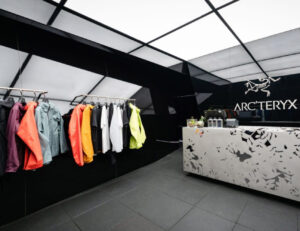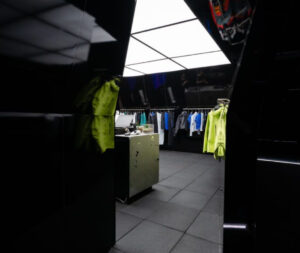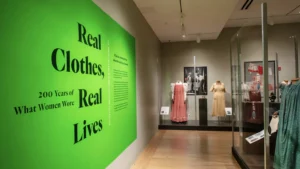
Experiential marketing has evolved significantly over the years, shifting from traditional product showcases to immersive brand experiences that engage consumers on multiple levels. In 2025, brands are expected to take this to new heights by leveraging sensorial elements that go beyond visuals and tap into deeper human connections through sound, scent, and touch.
One brand that exemplifies this trend is Arc’teryx Equipment, which has pioneered an experiential retail concept in Shanghai that reimagines the way consumers interact with their products. The brand’s “forest in the heart of the city” pop-up experience for their System_A Komorebi collection merges outdoor adventure with urban living by offering a multi-sensory experience that engages guests in ways traditional retail spaces do not.
Experiential Trends in 2025: The Shift Toward Sensorial Engagement
The experiential landscape is rapidly evolving, and in 2025, sensory overload will be a dominant trend in brand activations. Consumers today crave experiences that are not only visually compelling but also deeply engaging across multiple senses.
While some brands are cautious about overstimulating their audience, others—like Arc’teryx—are pushing the boundaries, using sensorial immersion to create unforgettable experiences. By incorporating three key elements—sound, scent, and texture—into their Shanghai pop-up, Arc’teryx has set a benchmark for how brands can captivate their audience in a crowded marketplace.
Arc’teryx’s System_A Collection: Fusing Function with Lifestyle
The System_A Komorebi collection is designed for a younger, style-conscious audience who demand versatility in their everyday wear. Built with GORE-TEX 3L fabric, the collection offers waterproof and windproof protection, making it ideal for urban adventurers who want performance without compromising style.
Arc’teryx’s core philosophy, “Worn When It Counts,” speaks to the brand’s dedication to crafting gear that empowers users to focus on the adventure rather than the elements. This ethos was brought to life in their Shanghai pop-up, where the brand successfully bridged the gap between outdoor exploration and the city environment.
Creating a “Forest in the Heart of the City”: Arc’teryx’s Three Immersive Elements
The Shanghai pop-up store was designed not just as a retail space but as an art installation that transported visitors into the great outdoors through carefully curated sensory experiences. Arc’teryx leveraged three key elements to achieve this:
Sound Experience: Bringing Nature to the City
The power of sound in creating immersive environments cannot be overstated. At the Arc’teryx pop-up, nature-inspired audio landscapes played throughout the space, replicating the sounds of a forest—rustling leaves, chirping birds, and the distant babble of a brook. This auditory layer was carefully designed to evoke the serenity and tranquility of outdoor adventure, offering guests a mental escape from the bustling city.
•Emotional Connection: Sound has a profound effect on emotions, and by replicating natural environments, Arc’teryx created a calming atmosphere that aligned with their brand identity.
•Brand Recall: Auditory cues have strong recall power, making it more likely for guests to remember their experience and associate it with Arc’teryx’s products.
•Immersion: The constant presence of natural sounds blurred the line between reality and imagination, deepening the sensory engagement of the pop-up.
Scent Experience: Engaging Memories Through Fragrance
Scent is one of the most powerful triggers of memory and emotion. To create an immersive forest atmosphere, Arc’teryx diffused forest-inspired scents through mist clouds, filling the space with the earthy, fresh aroma of pine, moss, and rain.
•Memory Retention: Studies show that scent is closely linked to memory, making this experience deeply personal and long-lasting.
•Mood Enhancement: The natural aroma had a calming and grounding effect on visitors, reinforcing Arc’teryx’s brand message of being in tune with nature.
•Brand Differentiation: Few retail spaces incorporate scent to this degree, setting Arc’teryx apart from competitors and creating a truly unique experience.
Texture Experience: The Power of Tactile Engagement
Texture plays a crucial role in making an experience feel tangible and real. Arc’teryx used textured plastic flooring designed to replicate the sensation of walking on a muddy trail, adding an unexpected yet immersive tactile element to the pop-up.
The Impact:
•Heightened Realism: The physical sensation of uneven ground added to the authenticity of the forest-like atmosphere.
•Deeper Engagement: Tactile experiences create a stronger sense of connection, encouraging visitors to explore and engage more actively.
•Storytelling Reinforcement: By simulating the feeling of hiking terrain, Arc’teryx reinforced their brand promise of outdoor performance.
Why Multi-Sensory Experiences Matter
The human brain processes multisensory information more effectively than single-sensory stimuli, making immersive experiences more memorable and impactful. Arc’teryx’s pop-up exemplifies how brands can leverage sight, sound, scent, and touch to create a holistic experience that resonates on a deeper emotional level.
Key Benefits of Sensory Engagement:
Enhanced Brand Recall: Multi-sensory experiences leave a stronger imprint in the minds of consumers, increasing brand retention.
Emotional Connection: Engaging multiple senses creates an emotional bond between consumers and the brand.
Increased Foot Traffic: Unique and engaging experiences attract more visitors, generating buzz and organic social sharing.
Higher Purchase Intent: When customers are emotionally connected to an experience, they are more likely to make a purchase.
Lessons for Brands Looking to Adopt Sensory Experiences
As we move into 2025, brands across industries can take inspiration from Arc’teryx’s approach to experiential marketing. Here are key takeaways for businesses looking to implement sensory elements in their activations:
Start with Storytelling: Ensure the sensory elements align with your brand narrative and create a cohesive experience.
Curate Each Element Carefully: Each sensory touchpoint should be thoughtfully designed to enhance the overall experience.
Encourage Interaction: Give consumers opportunities to touch, feel, and explore products in ways that deepen engagement.
Leverage Social Sharing: Sensory experiences are inherently shareable—encourage visitors to capture and share their journey online.
The Future of Retail: Sensory-Driven Spaces
As digital commerce continues to grow, physical retail spaces must evolve to offer something that online shopping cannot—sensory immersion. The Arc’teryx pop-up in Shanghai provides a glimpse into the future, where stores are no longer just about selling products but about creating memorable brand experiences.
Brands that embrace sensory engagement will not only attract foot traffic but also build stronger relationships with consumers, fostering loyalty and long-term brand affinity.
Impression
Arc’teryx Equipment’s innovative Shanghai pop-up is a testament to the power of sensory immersion in shaping the future of experiential marketing. By integrating sound, scent, and texture into their retail space, they have created a compelling, multi-dimensional experience that resonates with their audience and enhances their brand identity.
As we step into 2025, brands that prioritize experiential, sensory-driven marketing will stand out in an increasingly competitive landscape, offering consumers not just products, but unforgettable experiences that engage the senses and stir emotions.
No comments yet.








